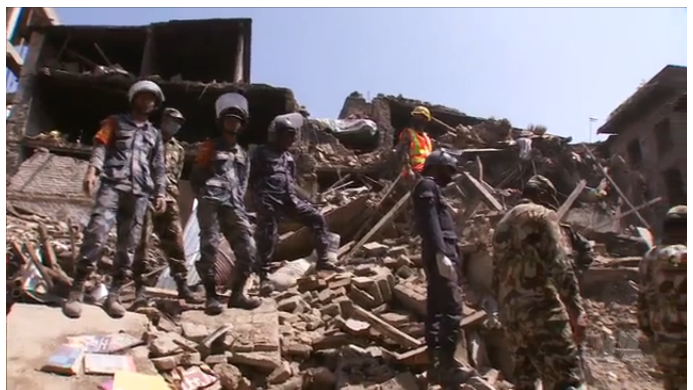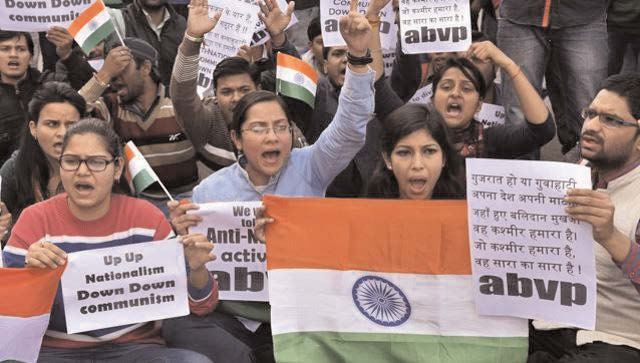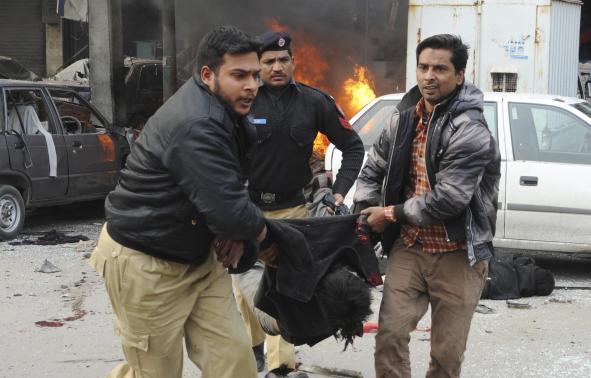
BHAKTAPUR, Nepal — Rescuers struggled to reach Nepal’s more rural communities on Monday to assess the damage from a devastating earthquake that has left more than 3,800 people dead.
[quote_box_right]Hit by severe shortage of food, water, electricity and medicines and buffeted by fear, tens of thousands of people are out in the open here as quake-hit Nepal today desperately sought international help to tide over a looming crisis with death toll soaring.[/quote_box_right]
The 7.8-magnitude earthquake struck Saturday, killing thousands and flattening centuries-old buildings in the capital city of Kathmandu. The temblor also sparked a deadly avalanche on Mount Everest.
Kathmandu residents were continuing to sleep outside following two days of powerful aftershocks. The official death toll jumped above 3,800 on Monday, with more than 7,100 others injured, according to Nepal’s National Emergency Operation Center. Aid agencies warned that figure could leap higher once rescuers make it to isolated rural communities.
“Villages in the areas affected near the epicenter are literally perched on the sides of large mountain faces and are made from simple stone and rock construction,” Matt Darvas, a Nepal-based worker with the Christian charity World Vision, said in a statement from the group.
More than 48 hours after the 7.9 magnitude temblor shook the Himalayan nation, injuring more than 8,000 people and leaving thousands more homeless, multi-nation rescue teams, including from India, carried out relief works.
Armed with modern equipment, dumpers and earth removers and aided by sniffer dogs, disaster relief workers were trying to locate possible survivors against fading hopes.
The quake that flattened homes and buildings and the subsequent powerful aftershocks forced people out to live in the open under plastic tents barely shielding them from cold and rains that pounded the city last night.
Fuel and medicines were also in short supply. The picture was the same in suburbs of Kathmandu and in other rural areas.
Nepal’s top bureaucrat Leela Mani Paudel said the immediate and big challenge was relief. “We urge foreign countries to give us special relief materials and medical teams. We are really desperate for more foreign expertise to pull through this crisis,” he said.
“We are appealing for tents, dry goods, blankets, mattresses, and 80 different medicines that we desperately need now,” he told a press conference.
Nepal does not have helicopters or the expertise to rescue survivors. It needs help in the form of orthopaedic doctors, nerve specialists, anaesthetists, surgeons and paramedics, Paudel said.
Hundreds of people are still trapped under tonnes of rubble in capital Kathmandu and some of the worst-affected remote mountainous areas amid concerns that toll could cross 5,000 mark, authorities said.
“The death toll in Nepal from the earthquake that struck two days ago has risen to 3,726,” Nepalese police spokesman Kamal Singh Bam said today.
Home ministry’s disaster management division said nearly 7,000 people were injured. 1,053 people are reported killed in the Kathmandu Valley alone and 875 in Sindhupalchowk.
Officials and aid agencies have warned that the casualties could rise as rescue teams reach remote mountainous areas of western Nepal.
“Villages are routinely affected by landslides, and it’s not uncommon for entire villages of 200, 300, up to 1,000 people to be completely buried by rock falls,” aid agency World Vision spokesman Matt Darvas said.
The blocked roads, downed power lines and overcrowded hospitals along with fresh tremors are hampering rescue efforts to locate survivors of the quake.
More than 700 disaster relief experts drawn from the National Disaster Relief Force have been deployed by India.
India has mounted a major rescue and rehabilitation effort, deploying 13 military aircraft which carried field hospitals, medicines, blankets, 50 tonnes of water and other materials.
A senior-level inter-ministerial team from India has arrived here to assess how India can assist in the relief operations. Teams of health experts from AIIMS and Safdarjung hospital Delhi have also been deployed.
Mass cremations are being held here continuously. As the death toll rises, the authorities are working on disposing of the bodies as quickly as possible to prevent a health hazard.
Nepal has declared a state of emergency in the wake of the disaster, the worst in over 80 years.
Aid flights are coming in continuously due to which Kathmandu airport is running out of parking bays. Many planes are having to wait before getting permission to land.
Chaos prevailed in the country’s only international airport here with hundreds waiting to be evacuated.
While 2,500 Indians have been evacuated so far, scores of people were still waiting outside the Tribhuvan International Airport to board commercial and defence aircraft to head for home.
UN agencies say Nepal is running out of water and food and nearly one million children urgently need humanitarian assistance as they were particularly vulnerable.





Be the first to comment